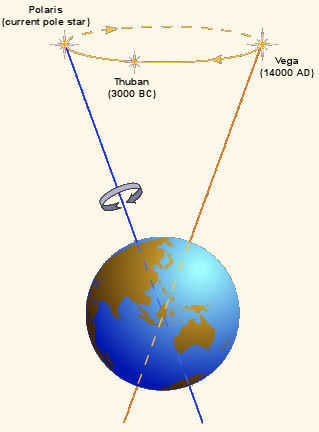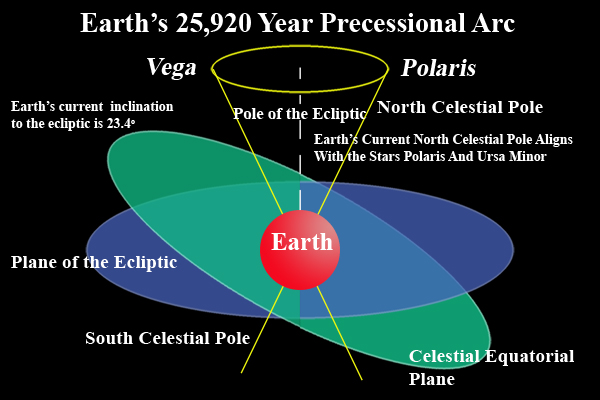The tropical zodiac DOES account for precession.
Sideralists who claim that only the sidereal zodiac accounts for precession should check their logic circuits.
The two zodiacs account for precession in two different but equally valid ways.
The tropical zodiac allows for determination -- by observation -- of the vernal equinox (0 degrees Aries by definition in that system) during any year.
The sidereal zodiac (claimed as the Only True Zodiac by some) is not based on any verifiable fact. Period. How many ayanamsas are there? A dozen at least. In which year did coincidence actually occur? No one knows. The precessional period is not regular; it has slight variations, sometimes caused by such minor perturbations as an earthquake (Concepcion). Where is "zero Aries" in the constellations? That point is purely arbitrary, unlike the vernal equinox.
It should also be noted that the Earth is not fixed in space. It apparently revolves around the Sun, the Sun (and solar system with it) around Sirius, and that complex around the galactic center. Therefore the insistence on using Earth's relationship to fixed stars (that are not fixed) is spurious.
If the scientific standard for theories and mathematical models called Parsimony (also called Occam's Razor) informs us how to judge the validity of theories and models, then the tropical zodiac wins the contest, because the tropical zodiac describes earth's relationship to the cosmos in a simpler way. The sidereal zodiac depends on the fixed stars (which are not fixed in the first place), while the tropical zodiac works perfectly without them ever appearing in the sky. With the tropical zodiac we could create the signs as they exist today without ever having seen a star shine. This is not true for the sidereal zodiac.
If our astrology is geocentric, and the art deals with people who live on the Earth (they are also geocentric), then an Earth-centered system of measurement (determination of the vernal point) is appropriate. It does not rely on far-distant stars as its frame of reference.
It seems to me absurd to put Capricorn in the middle of summer (totally out of character for the sign's significance), which is what the sidereal zodiac does during a lengthy period in each precessional cycle. Capricorn is always a winter sign in the tropical zodiac.
We should keep in mind a very elementary fact. Constellations and signs are not concrete facts, but are constructs of man's mind. They have no substance in reality. The entire fabric of astrology is a construct of man's mind. The reason it works is because man's mind, like the solar system itself, is one with the all. Physical laws that are valid on Earth are also operative in the farthest reaches of the universe. And this also applies to non-physical laws. An example of a non-physical law is the Law of Karma, whiich careful observation of life will show to be true and consistently effective. This same underlying law can be expressed as a physical law, stated by Newton as "For every action there is an equal and opposite reaction." It can be stated also as "Whatsoever thou sowest, that also shall thou reap." These laws hold throughout the universe.
The constellations (and individual stars within them) were man's first points of reference for locating the wandering stars (planets) in the sky. The signs evolved out of the constellations as man began to apply mathematics to the natural world around him. But the constellations themselves are mental constructs. I "see" a scorpion by connecting the dots. An image (and a correlation, an analogy) is what creates the scorpion...not something inherent in the stars themselves.
Thus, man's mind functions according to this universal scheme, and his capacity for analogy (which is the basis for astrological symbolism -- including constellations and signs) is in harmony with the nature of the cosmos in any of its expressions. That is why astrology works.
I use the tropical zodiac. But I have absolutely no objection to the sidereal zodiac (pick the one you like best; sadly for me and my ilk, there is only one tropical zodiac). My only objection stems from the false claims of the more fanatical siderealists that theirs is the One True Faith. I can't recall ever seeing a tropicalist trying to proselytize the way many siderealists so often do. "The lady doth protest too much, methinks."
Miquar, I don't think your question has a definitive answer. The variations in the precessional cycle (period) can only be determined by observation, and are not precisely predictable in the abstract. What is past and unobserved is lost. There are, I believe, at least 4 or 5 causes (forces that influence and affect) for Earth's nutation, and slight variation in any one of them affects the precessional period. As mentioned, unpredictable events such as large earthquakes add their grain of sand to the pile as well.




